Dissecting the Music of Eli Roth’s THANKSGIVING
Skewer Your Funny Bone: Recommended for Strong Stomachs
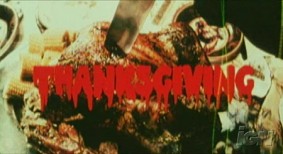
The short film Thanksgiving, posing as a faux trailer, was one of the highlights of Grindhouse, the Robert Rodriguez and Quentin Tarantino collaboration. Those two-and-a-half minutes (a pound?) are the best of Eli Roth’s resume. It is both a loving homage to John Carpenter’s definitive film Halloween (1978) and an inspired parody of those awful 80s slasher-rip-off-flicks (and bad taste, in general) that is far elevated from Roth’s turgid Hostel films. A.O. Scott of The New York Times wrote, “In any case be sure not to miss the trailer for Thanksgiving — not for the squeamish or the humor impaired, and not that you’d necessarily want to see the movie, if it existed.”
I remember the first time seeing it in theaters, the last act of abomination by the Evil Pilgrim on the roasted turkey had me laughing so hard throughout the main title sequence of Quentin Tarantino’s Death Proof, the best of both feature films. In the Kurt Volk designed collectible hardcover book Grindhouse, which chronicles behind its scenes, its director Eli Roth wrote a fascinating article about making Thanksgiving in Prague after dressing it up as Small Town, America. The read is explores technical as well as the drama creating these sick scenes (God love ’em!) to round out Roth’s gut-busting observations. It’s a mixed blessing Thanksgiving won’t be getting the Grindhouse feature treatment, we already have the best parts. Why let a lame narrative ruin that?
My only grip about this really guilty pleasure is this: What is the deal with not listing John Harrison as the composer of Thanksgiving in the end credits of the cheerfully sleazy three-hour double-feature? The majority of the music is lifted right off the soundtrack of George A. Romero’s immortal five-part Creepshow (1982), which was based on a Tales From the Crypt-like graphic novel written by Stephen King as the film’s screenplay.
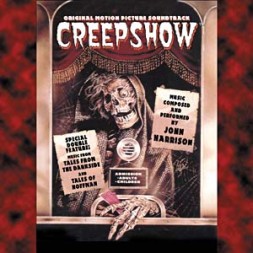 In Thanksgiving, you’ll hear excerpts from Father’s Day, a Creepshow episode where Aunt Bedelia (Viveca Lindfors, A Wedding, 1978) is strangled to death by her cake-obsessed zombie-dad (John Amplas, Martin, 1977), which stands in as the Evil Pilgrim’s murderous theme song. Then the trampoline scene (Holy-NC-17-MPAA!) is accompanied by the music used for Something to Tide You Over when a jealous husband (Leslie Neilsen, The Naked Gun Series) watches, from the comfort of his living room, his wife and her lover drowning (Eat you heart out Peter Greenaway). Lastly, the sickly build-up to the near-thirty-year-old-depicting-a-teen (Eli Roth) head scene is from the They’re Creeping Up On You segment staring E.G. Marshall (Double Indemnity, 1944) as a corrupt, cockroach-phobic CEO. All are compositions by John Harrison.
In Thanksgiving, you’ll hear excerpts from Father’s Day, a Creepshow episode where Aunt Bedelia (Viveca Lindfors, A Wedding, 1978) is strangled to death by her cake-obsessed zombie-dad (John Amplas, Martin, 1977), which stands in as the Evil Pilgrim’s murderous theme song. Then the trampoline scene (Holy-NC-17-MPAA!) is accompanied by the music used for Something to Tide You Over when a jealous husband (Leslie Neilsen, The Naked Gun Series) watches, from the comfort of his living room, his wife and her lover drowning (Eat you heart out Peter Greenaway). Lastly, the sickly build-up to the near-thirty-year-old-depicting-a-teen (Eli Roth) head scene is from the They’re Creeping Up On You segment staring E.G. Marshall (Double Indemnity, 1944) as a corrupt, cockroach-phobic CEO. All are compositions by John Harrison.
The only original pieces of music by Nathan Barr, who was credited, are what follow: First, that menacing music at the beginning of trailer — following the knife-wielding maniac Halloween-style behind the buck-toothed screaming Grandma. And last, that perfectly drippy, romantic, synthesized 80s-like score playing over “Cool it, Judy! You’re safe. Bobby’s here…”
It seems strange, but this is the way credits work most of the time where original music versus licensed music is concerned. It’s not a matter of giving credit to the composer with the most music in the trailer, but rather giving credit for the most-recent music written specifically for that fake trailer.
CREEPSHOW (1982) Trailer
GRINDHOUSE (2007) Trailer 1
GRINDHOUSE (2007) Trailer 2


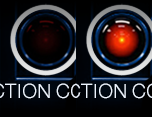











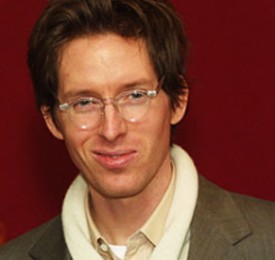 Wes Anderson, the director of Bottle Rocket (1996), the classic Rushmore (1998) and The Darjeeling Limited (2007), will helm the Fox Animation production based on the Roald Dahl novella The Fantastic Mr. Fox. The script has been adapted by Anderson and Noah Baumbach (Kicking and Screaming, 1995, The Squid and the Whale, 2005), who both collaborated on the screenplay of Anderson’s own The Life Aquatic with Steve Zissou (2004) — “I’ve never seen a bond company stooge stick his neck out like that.”
Wes Anderson, the director of Bottle Rocket (1996), the classic Rushmore (1998) and The Darjeeling Limited (2007), will helm the Fox Animation production based on the Roald Dahl novella The Fantastic Mr. Fox. The script has been adapted by Anderson and Noah Baumbach (Kicking and Screaming, 1995, The Squid and the Whale, 2005), who both collaborated on the screenplay of Anderson’s own The Life Aquatic with Steve Zissou (2004) — “I’ve never seen a bond company stooge stick his neck out like that.”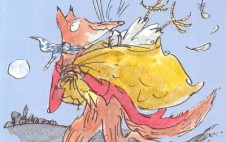 The Roald Dahl tale is about a wily fox who outwits a group of farmers out of their produce. Just imagine Max Fischer with orange fur and a tail. Mr. Fox will be voiced by the equally wily George Clooney. There is confirmation that Wes Anderson alumni such as Cate Blanchett, Jason Schwartzman, Bill Murray (sound the trumpets!), and Anjelica Huston will lend their vocal talents as well.
The Roald Dahl tale is about a wily fox who outwits a group of farmers out of their produce. Just imagine Max Fischer with orange fur and a tail. Mr. Fox will be voiced by the equally wily George Clooney. There is confirmation that Wes Anderson alumni such as Cate Blanchett, Jason Schwartzman, Bill Murray (sound the trumpets!), and Anjelica Huston will lend their vocal talents as well.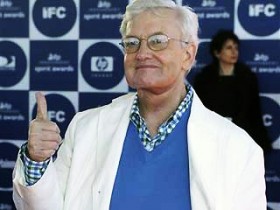 One of the new special features for the upcoming Director’s Cut DVD of Alex Proyas’ Dark City (1998) due on July 29th, 2008 is a brand new audio commentary track by Roger Ebert. Whether he recorded at the same time before the first DVD was released on July 1998 or sometime again before 2005 when Ebert had surgery on his salivary gland. The operation was botched when his carotid artery burst, leaving him in intensive care for over a year, and costing him his ability to speak.
One of the new special features for the upcoming Director’s Cut DVD of Alex Proyas’ Dark City (1998) due on July 29th, 2008 is a brand new audio commentary track by Roger Ebert. Whether he recorded at the same time before the first DVD was released on July 1998 or sometime again before 2005 when Ebert had surgery on his salivary gland. The operation was botched when his carotid artery burst, leaving him in intensive care for over a year, and costing him his ability to speak.
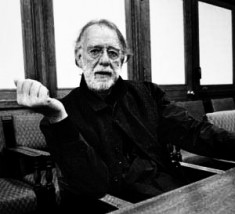 Reggio’s Qatsi Trilogy and Animi Mundi present moving imagery of landscapes from around the world that are manipulated by time-lapse techniques set to unique scores by Philip Glass. Savage Eden is a bit different, being described as a film that combines “narrative and non-narrative cinema”. Much like Reggio’s previous works, it will mostly be devoid of plot and characters. Reggio vaguely elaborates on the title during an interview with
Reggio’s Qatsi Trilogy and Animi Mundi present moving imagery of landscapes from around the world that are manipulated by time-lapse techniques set to unique scores by Philip Glass. Savage Eden is a bit different, being described as a film that combines “narrative and non-narrative cinema”. Much like Reggio’s previous works, it will mostly be devoid of plot and characters. Reggio vaguely elaborates on the title during an interview with 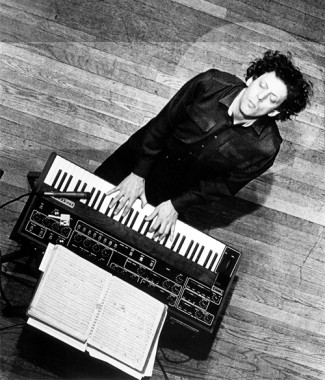 Glass: A Portrait of Philip in Twelve Parts is a new documentary about one of the greatest living composers from the last century, is in limited release now. The film, set for release at the Toronto Film Festival in 2007, marks Philip Glass’ 70th year. Scott Hicks, the director of Shine (1996 — one of the best films of the 1990s), has jumped at the chance to document Glass for a year while collaborating on music for his film No Reservations (2007). Hicks had been granted access behind the curtains and inside Glass’ home to present the artist more intimately. The documentary presents twelve different aspects of Glass, much like François Girard did for Thirty Two Short Films About Glenn Gould (1993), a fictional account of the eccentric Canadian classical pianist who died in 1982. The Girard film was also one of the very best films of 1994.
Glass: A Portrait of Philip in Twelve Parts is a new documentary about one of the greatest living composers from the last century, is in limited release now. The film, set for release at the Toronto Film Festival in 2007, marks Philip Glass’ 70th year. Scott Hicks, the director of Shine (1996 — one of the best films of the 1990s), has jumped at the chance to document Glass for a year while collaborating on music for his film No Reservations (2007). Hicks had been granted access behind the curtains and inside Glass’ home to present the artist more intimately. The documentary presents twelve different aspects of Glass, much like François Girard did for Thirty Two Short Films About Glenn Gould (1993), a fictional account of the eccentric Canadian classical pianist who died in 1982. The Girard film was also one of the very best films of 1994.